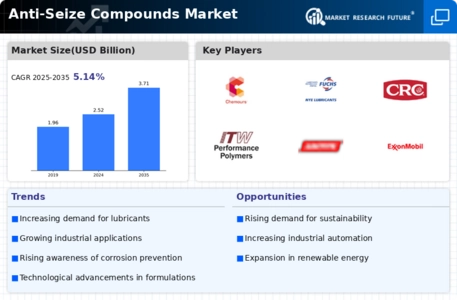Expansion in Aerospace Applications
The aerospace industry is increasingly adopting anti-seize compounds to address the unique challenges posed by high-altitude and high-stress environments. The anti-seize compounds market is likely to experience growth as aerospace manufacturers recognize the importance of preventing galling and seizing in critical components. With The Anti-Seize Compounds projected to reach over 800 billion USD by 2025, the demand for specialized materials, including anti-seize compounds, is expected to rise. These compounds are essential for ensuring the safety and reliability of aircraft, particularly in engine components and fasteners. As the aerospace sector continues to expand, the anti-seize compounds market is poised to capitalize on this trend, providing solutions that enhance performance and safety in aviation applications.
Increasing Demand in Automotive Sector
The automotive sector is witnessing a notable surge in demand for anti-seize compounds, primarily due to the growing complexity of vehicle designs and the need for enhanced durability. As vehicles incorporate more advanced materials and components, the risk of seizing and galling increases, necessitating the use of anti-seize compounds. The anti-seize compounds market is projected to benefit from this trend, with estimates suggesting a compound annual growth rate of approximately 5% over the next few years. This growth is driven by the need for reliable performance in high-temperature and high-pressure environments, which are common in modern automotive applications. Consequently, manufacturers are increasingly integrating anti-seize solutions into their production processes to ensure longevity and reliability, thereby propelling the anti-seize compounds market forward.
Technological Innovations in Formulations
Technological advancements in the formulation of anti-seize compounds are driving the evolution of the anti-seize compounds market. Innovations such as the development of environmentally friendly formulations and enhanced performance characteristics are becoming increasingly important. Manufacturers are investing in research and development to create products that not only meet stringent regulatory requirements but also offer superior protection against corrosion and wear. The market data suggests that the introduction of advanced formulations could lead to a 10% increase in market share for companies that prioritize innovation. As industries become more aware of the benefits of using high-performance anti-seize compounds, the market is likely to see a shift towards these innovative solutions, thereby enhancing overall product offerings and customer satisfaction.
Growing Awareness of Maintenance Practices
There is a growing awareness among industries regarding the importance of maintenance practices, which is positively impacting the anti-seize compounds market. As organizations recognize the cost implications of equipment failure, they are increasingly adopting preventive maintenance strategies that incorporate anti-seize solutions. This trend is particularly evident in sectors such as oil and gas, manufacturing, and automotive, where equipment reliability is critical. The anti-seize compounds market is expected to benefit from this shift, as companies seek to minimize downtime and extend the lifespan of their machinery. Market data indicates that businesses investing in maintenance solutions can reduce operational costs by up to 30%, further underscoring the value of anti-seize compounds in maintenance strategies. Consequently, the emphasis on proactive maintenance is likely to drive demand for anti-seize compounds in various industrial applications.
Rising Industrial Manufacturing Activities
The resurgence of industrial manufacturing activities across various sectors is significantly influencing the anti-seize compounds market. As industries ramp up production to meet increasing consumer demand, the need for reliable maintenance solutions becomes paramount. Anti-seize compounds are essential in preventing equipment failure and ensuring smooth operations in manufacturing environments. The market data indicates that the industrial manufacturing sector is expected to grow at a rate of 4% annually, which directly correlates with the rising demand for anti-seize solutions. This growth is particularly evident in sectors such as construction, machinery, and heavy equipment, where the risk of seizing is prevalent. Thus, the anti-seize compounds market stands to benefit from the ongoing industrial expansion, as manufacturers seek to enhance equipment longevity and operational efficiency.

















Leave a Comment